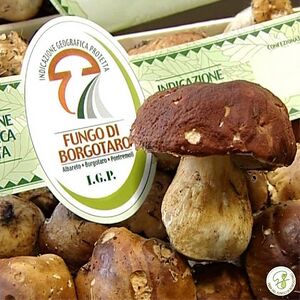Fungo di Borgotaro (Borgotaro mushroom)
IGP Fungo di Borgotaro is a carpophores of Boletus taken from the spontaneous growth of Boletus aestivalis, Boletus pinícola, Boletus aereus and Boletus edulis.

NAME: Fungo di Borgotaro (Borgotaro mushrooms) - "Borgotaro" is a Commune in the area of production which gives its name to the mushrooms coming from the area of production indicated
DESCRIPTION: colour: from white-light brown to dark reddishbrown, depending on the variety; very pleasant odour and flavour; consistency: very soft compared to other mushrooms.
GEOGRAPHICAL AREA: in the appropriate areas of the Provinces of Parma and Massa Carrara, which include the Communes of Borgotaro and Albareto in tne Province of Parma and the Commune of Pontremoli in the Province of Massa Carrara.
EVIDENCE: An early testimony to the production of pore mushrooms in the area of production identified by the IGP "Fungo di Borgotaro" ("Borgotaro mushroom") is found in the work "istoria di Borgo Val di Taro che riguarda insieme la mutazione dei domini in Italia e Lombardia sotto i Pontefici, i Re, gli Imperatori di occidente da Carlo Magno e come molte città si fecero Repubbliche" ("History of Borgo Val di Taro regarding the change of rule in Italy and Lombardy under Popes, Kings and Western Emperors from Charlemagne, and How Many Cities became Republics") written by A.C. Cassio (1669-1760). This work illustrates the mushroom's properties, the area of production (which corresponds with that of the IGP) and the methods used for the gathering and distribution of the product. Further evidence on the production of this mushroom is provided by the topographical dictionary cf the Duchy of Parma, Piacenza and Guastalla by Lorenzo Molossi (Parma 1832-1834) and from the book by D. Tommaso Grilli "Manipolo di cognizioni con cenni storici di Albareto, di Borgotaro" (Collection of Notions with a Historical Account of Albareto and Borgotaro") published in 1893 which talks about the activities carried out in the area and which mentions specifically the presence and importance of the area's mushroom production, describing also the customs of gathering and processing the mushrooms. By the end of the 19th century, the processing and marketing of this product had become important enough to supply a flourishing export trade, especially to North and South America. A summary of the problems connected with the Borgotaro mushroom is contained in an article by C. Bellini written in 1933 and which appeared in Avvenire agricolo and which was published again in 1975 by the Associazione "A. Emmanuelli", which pointed out the necessity of obtaining the authorization of the "so-called mark of origin".
Given the importance of this product, in 1928 the town council of Borgotaro instituted a special regulation for the selling of the product, particularly in the dried form, at a market taking place twice weekly. In 1964 the Consorzio delle Comunalie Parmensi (Parmesan Communes Consortium) became the organizer for Borgotaro mushroom promotional activities and submitted an application for its geographic recognition on 10 July 1989.
METHOD OF PRODUCTION: IGP "Fungo di Borgotaro" ("Borgotaro mushrooms") is limited to fresh mushrooms of the genus "Boletus" growing spontaneously in the appropriate areas of the Communes of Borgotaro and Albareto in the Province of Parma and the Commune of Pontremoli in the Province of Massa Carrara. The woods intended for Borgotaro mushroom production must have the environmental conditions traditional to that area. The woods appropriate for the production of Borgotaro mushrooms must be of trees entirely of one of the following species or of a mixture of these same species:
a) broadleaf trees: beech, chestnut, Turkey oak and other oak species, hornbeam, European aspen;
b) conifers: silver fir, spruce, Scotch pine, black pine. Pseudosuga menzienzii, grown as coppice, mixed coppice and high forest both naturally occurring and from conversion.
LINK: In the Parmesan Apennines, the woods surrounding the Commune of Borgotaro have given great renown to a special, spontaneously growing product. These fresh Boletus mushrooms have an intense, delicate scent with a particular, characteristic aroma which distinguishes them from carpophores from other provinces. Numerous documents from distant times bear witness to the excellent qualities of this product coming from the area mentioned above. However, it became economically important only at the end of the 19th century, with the founding of the first companies to process and market the Borgotaro mushroom, with a process for drying them and, at the same time, with the developing of the market throughout Italy and the foreign export market.
Reference: The European Commission